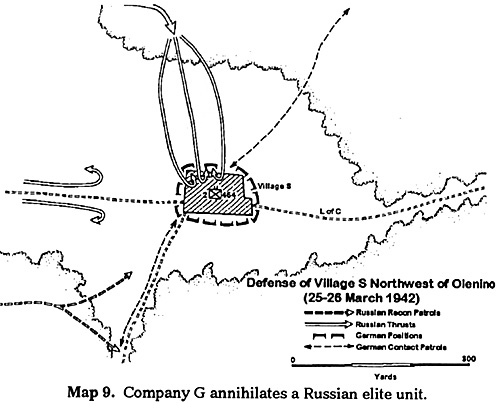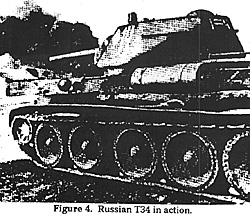
During March 1942 Russian pressure from the north and west forced the Germans to make a limited withdrawal northwest of Rzhev. In late March the 2d Battalion of the German 464th Infantry Regiment, including Company G, established defensive positions in Village S, about 12 miles northwest of Olenino. The village was situated on level ground and was faced by forests to the north, east, and south. The terrain to the west was open, permitting the defenders to detect at an early moment the approach of any Russian forces coming from that direction. Since the German forces in the area were not strong enough to establish a continuous defense line, the village was organized for perimeter defense. The battalion constructed snow positions above the ground, excavation of the frozen soil being impossible, and maintained contact with adjacent units by sending patrols through the forests around the village.
On 25 March the low temperature was -44 degrees F and 3 feet of snow covered the ground. On that day the 2d Battalion repelled several attacks from the west, inflicting heavy losses on the Russians, who then intensified their patrol activity (see Map 9).
Before dawn on 26 March a reconnaissance patrol sent out by Company G returned from the forest bordering Village S to the north without having encountered enemy troops. The distance from the edge of the forest to the defense perimeter measured approximately 150 yards. Half an hour after the return of the German patrol 100 Russians suddenly emerged from the forest and attacked Company G at the northwestern part of the defense ring. The Russians participating in the attack were armed with submachine guns and moved on skis, which made the small force exceedingly mobile in the snow-covered terrain. In addition, every third man carried a frangible grenade in his pocket, presumably for the purpose of setting fire to the village. Several Russians literally blew up when their frangible grenades were struck by bullets and exploded. Because of the severe cold some of the German machine guns failed to function, and the Russians succeeded in penetrating the German positions.
 Half an hour later Company G counterattacked in order to eliminate the penetration. The Russians fought tenaciously, and there was violent hand-tohand combat. By 1200 Company G had recaptured the positions. Eighty-nine Russians were killed and nine, including two seriously wounded, taken prisoner. All of the attackers were NCO candidates who had been promised battlefield promotions if they captured Village S.
Half an hour later Company G counterattacked in order to eliminate the penetration. The Russians fought tenaciously, and there was violent hand-tohand combat. By 1200 Company G had recaptured the positions. Eighty-nine Russians were killed and nine, including two seriously wounded, taken prisoner. All of the attackers were NCO candidates who had been promised battlefield promotions if they captured Village S.
While Company G was mopping up the area, brief hand-to-hand fighting suddenly flared up at two points where prostrate Russians, suddenly coming to life, jumped to their feet and assaulted the German soldiers.
This example illustrates how effectively the Russian riflemen exploited the terrain when approaching the enemy, even in deep snow and extreme cold. The attack was conducted skillfully and silently, and Best use was made of the element of surprise. The entire assault force rushed out of the forest and attacked in a single wave. However, when the surprise attack did not result in the immediate capture of the village but led to a struggle for the German positions, the operation lost its tactical value since the Russian unit had gone into battle without any support. Instead of breaking off the engagement and withdrawing, the Russians continued fighting until their entire force was wiped out.
This action, however, does not lend itself to generalization since a special Russian unit composed of noncommissioned officer candidates was involved. Except for the resistance offered to the German advance in the summer of 1941 by certain Russian elite formations, no other Russian units had fought so violently and tenaciously.
During World War II the training status of different Russian units showed such great variations that generalizations based on the performance of individual units are not permissible. As in any other army, there were both good and indifferent units among the innumerable divisions which opposed the Germans. Training courses at Russian service schools were conducted with great thoroughness and even senior officers were subjected to the rigors of the ordinary training schedule. Training was not limited to the achievement of military proficiency; it was constantly over shadowed by political indoctrination designed to imbue every soldier with the ideological principles involved in the life-and-death struggle.
More Company G
-
Introduction
Company G Counterattacks During a Snowstorm (November 1941)
Company G Operates in Deep Snow (January 1942)
Russian Infantry Attacks a German-Held Town (January 1942)
Company G Struggles Against Overwhelming Odds (March 1942)
Company G Annihilates a Russian Elite Unit (March 1942)
Back to Table of Contents -- Combat Simulation Vol 1 No. 1
Back to Combat Simulation List of Issues
Back to MagWeb Magazine List
© Copyright 1994 by Mike Vogell and Phoenix Military Simulations.
This article appears in MagWeb (Magazine Web) on the Internet World Wide Web.
Other military history articles and gaming articles are available at http://www.magweb.com